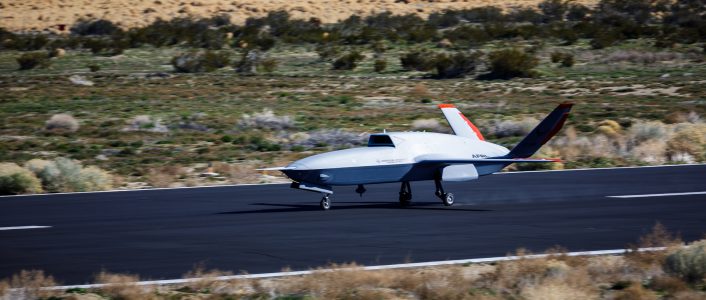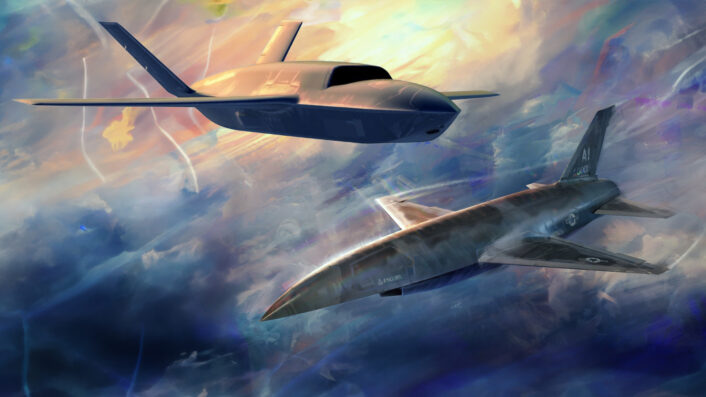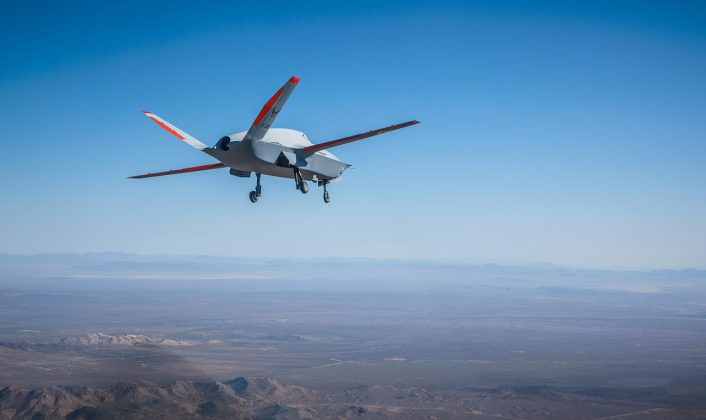With Demon Ape, General Atomics’ XQ-67A drone will leverage its modular architecture to provide testing for the U.S. Air Force’s Collaborative Combat Aircraft program.
General Atomics Aeronautical Systems has been awarded a sole-source contract for the U.S. Air Force Research Laboratory’s (AFRL) Demon Ape program, which will see the XQ-67A drone, revealed for the first time last year after its first flight in late February 2024, receive new upgrades. Demon Ape, an acronym for Demonstration of Autonomous Collaborative Platform Performance and Effectiveness, is a testing program connected to the Air Force’s larger Collaborative Combat Aircraft (CCA) advanced drone program, currently underway with competing projects from General Atomics and Anduril.
Demon Ape
The modifications that the XQ-67A will undergo as part of Demon Ape are not currently known, but an avenue of approach could reasonably be to convert the lateral bays in the forward fuselage hosting the large side-looking airborne radar (SLAR) sensors into weapons bays for air-to-air ordnance, a conversion consistent with the Off-Board Weapon Station (OBWS) program objective, or even air-to-ground munitions, covering the wider CCA goals.
The few non-redacted info accompanying the Jan. 17, 2025, contract notice doesn’t provide much details. However, the document says that GA-ASI “will have to integrate the specific mission systems” and “upgrade the vehicle to ensure equate power generation and thermal management capacity.”

The document also mentions that “there is only one XQ-67A aircraft in existence” and that it is “the only exiting aircraft designed and built from the genus/species concept that has gone through full airworthiness and flight demonstration.” Additionally, a first Demon Ape PH 1 contract was awarded in June 2024, although no details were provided.
The XQ-67 OBSS
The XQ-67A by General Atomics Aeronautical Systems (GA-ASI, the maker of the famous MQ-1 Predator and MQ-9 Reaper families of drones) was initially developed as part of the U.S. Air Force’s Off-Board Sensing Station (OBSS) program to provide an attritable forward radar node and a “sensor truck”.
The XQ-67A sports side-looking radars on both sides of the fuselage and would act as a distributed system to replace the recently retired E-8 JSTARS. The service is, in fact, shifting towards a distributed combination of manned and unmanned aircraft to cover this role.
The OBSS program evolved from the Air Force Research Laboratory’s Low Cost Attritable Aircraft Technologies (LCAAT) program that also originated the XQ-58A Valkyrie from American defense firm Kratos. LCAAT was aimed at designing and building unmanned combat aerial vehicles (UCAVs) at lower cost and in shorter times by leveraging better design tools and commercial manufacturing processes.
The technology and knowledge acquired was later transferred through the subsequent Low Cost Attritable Aircraft Platform Sharing (LCAAPS) program into OBSS. Kratos was awarded a contract in 2021, later losing to General Atomics in 2023, with GA-ASI then developing the XQ-67A, the first of the second generation of Autonomous Collaborative Platforms (ACP).
Both the XQ-67A and XQ-58A share a “genus” and “species” approach to designing and building the drones, leveraging standard substructures and subsystems and allowing different aircraft kits to be added to the airframe, like an Off-Board Sensing Station (OBSS) or Off-Board Weapon Station (OBWS). OBWS, disclosed by the U.S. Air Force in 2024, is expected to be the next drone in the family, taking the role of a missile-carrying loyal wingman.
The Collaborative Combat Aircraft
These capabilities are linked to the Collaborative Combat Aircraft (CCA) program whose development will be aided by the XQ-67A planes under the Demon Ape program. The Air Force said that the first tranche of CCAs airframes is expected to be able to perform the role of air-to-air missile trucks in close cooperation with manned jets, with air-to-ground strikes, electronic warfare, networking node, and intelligence, surveillance, and reconnaissance (ISR) capabilities potentially expected in future CCA drones.

The CCA program, who currently includes competing projects from General Atomics and Anduril, aims to develop autonomous unmanned aircraft able to cooperate in the “loyal wingman” role with current fifth- (the American F-22 and F-35 fighters) and sixth-generation (like the future NGAD) combat aircraft as part of manned-unmanned teaming concepts. The U.S. Air Force said in the past that it plans to procure 200 NGAD fighters along with 1,000 CCA, with between 100 and 150 of the latter being Increment 1 CCA airframes, the initial configuration.
Each NGAD airframe is expected to cost hundreds of millions of dollars, while the CCA drones are estimated to cost between $20.6 million and $27.5 million, “in the order of a quarter or a third” of the current unit cost of an F-35 and less than the price of a MQ-9 Reaper, which stands at roughly $32 million. CCAs are not considered expendable or attritable, but rather “systems that you can accept losses of a fraction of them and not have a big operational impact”.
Using the stealthy XQ-67A as a testbed to support the CCA program will also directly advance the OBSS program, providing “adequate power generation and thermal management capacity” (the official goals of the Demon Ape program, as explained in the contract award) for the sensors and systems that will be the payload of the XQ-67A.

OBSS and CCA have different goals, with OBSS being a sensor and CCA a shooter, but both live inside the larger USAF concept for future air superiority that will also include other drones with different roles, like EW and ground attack, while leveraging a common modular central core that allows to generate new variants faster by maintaining extensive commonality.









